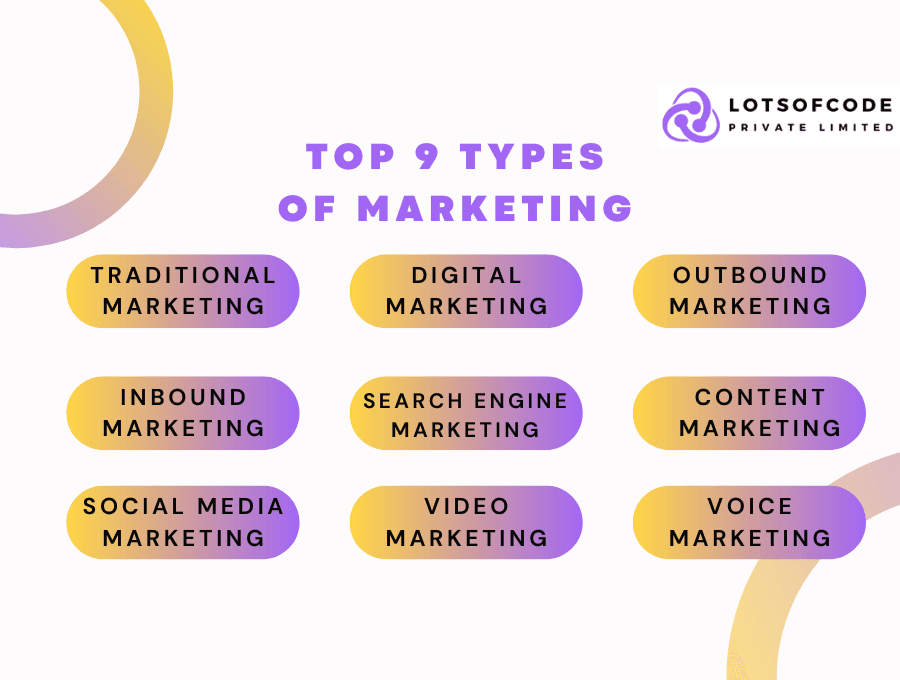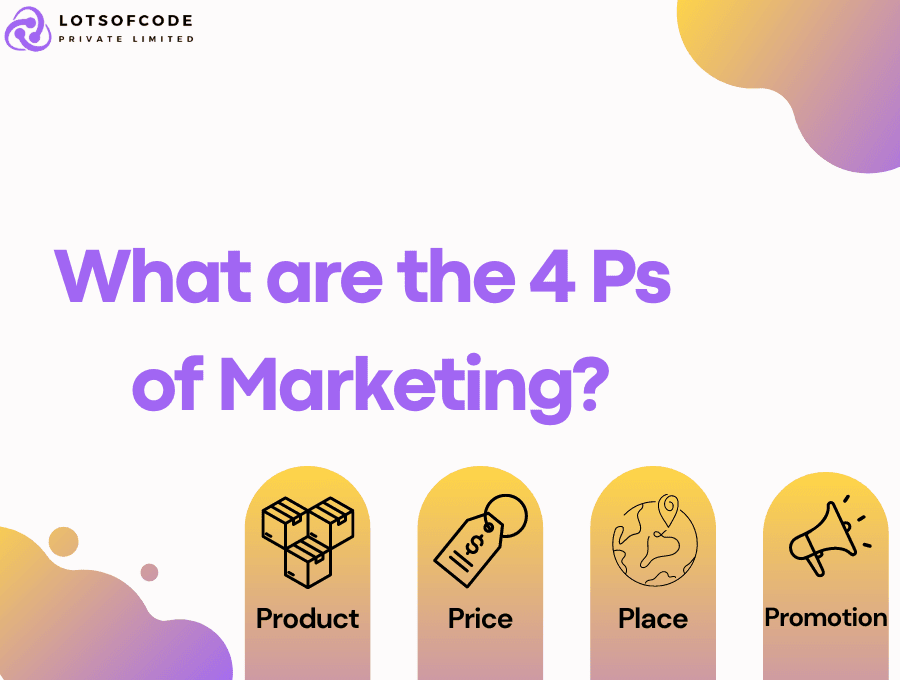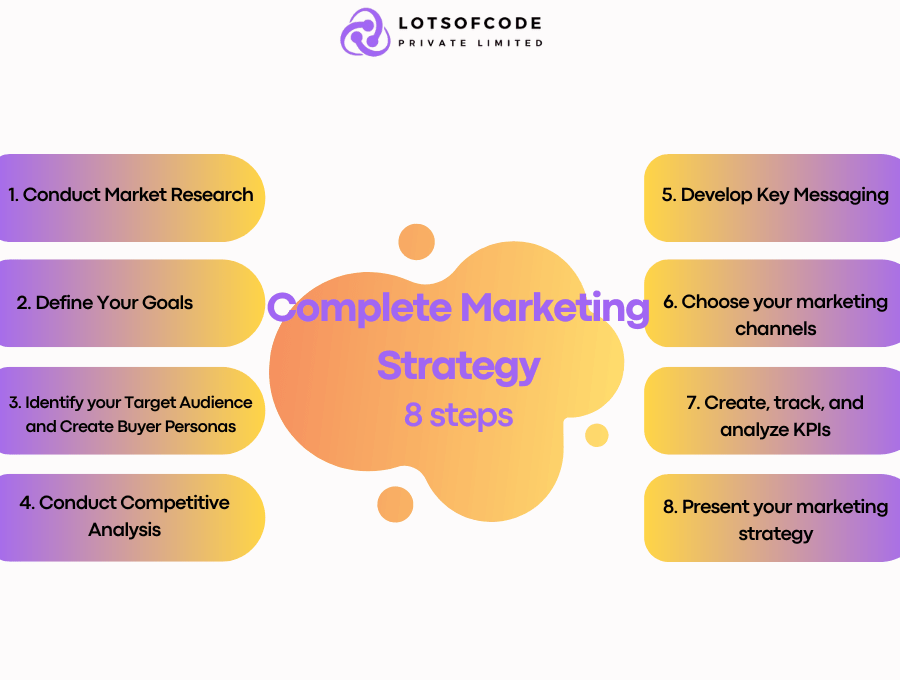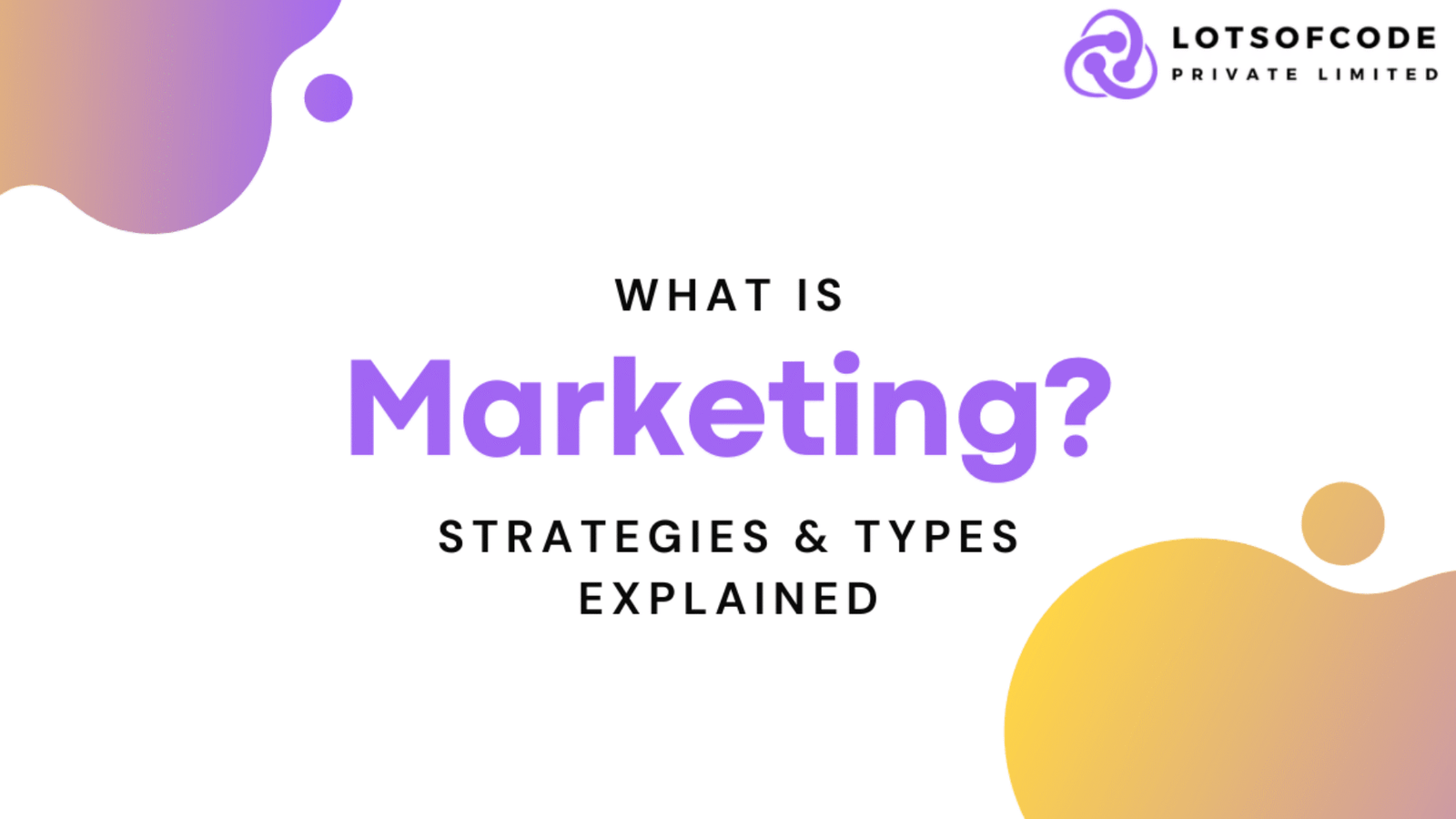Marketing is the process of planning and executing the development, pricing, distribution, and promotion of products and services to meet customer needs. It involves creating, communicating, delivering, and exchanging offerings that have value for customers, clients, partners, and society at large.
What is Marketing?
Marketing includes advertising and allows businesses to sell products and services to consumers, other businesses, and organizations. Marketing is present in all the stages of the business from starting to end.
The main purpose of Marketing is the research and analyze businesses’ consumers all the time, and study their online shopping behavior.
People who work in a company’s Advertising & Marketing department try to grab the attention of important groups of people who might want to buy their product. They do this by creating special offers and using eye-catching designs or famous people to convince these groups to choose their product. They also want to get their product seen in lots of places.
Marketing involves all the actions a company takes to build and maintain a relationship with its customers. Networking with past or potential customers by writing thank you emails or meeting with clients.
What Is the Purpose of Marketing?
Marketing might seem like it’s all about flashy ads and catchy slogans, but there’s a much bigger reason businesses invest in it. At its core, marketing is about connecting with the people who might benefit from what a company offers.
Imagine you bake the most delicious cookies in town. You could spend all day perfecting your recipe, but if no one knows they exist, you won’t have many customers. That’s where marketing comes in. It’s about spreading the word about your cookies, letting people know how yummy they are, and convincing them to try some for themselves.
The ultimate goal of marketing is to turn those interested people into paying customers. But it’s not just about making a quick sale. Successful marketing builds relationships. It convinces people that your product or service is the best choice for their needs, and keeps them coming back for more.
Here’s a breakdown of some key purposes of marketing:
Generate interest and buzz: Marketing helps capture people’s attention and get them excited about what a company has to offer. This can be done through creative advertising, social media engagement, or even sponsoring local events.
Educate potential customers: People don’t buy what they don’t understand. Marketing educates potential customers about a product or service, highlighting its features and benefits. It shows them how it can solve their problems or make their lives easier.
What are the Benefits of Marketing?
Believe it or not, a recent survey showed that over a third (37%) of small businesses don’t even have a website! They might be thinking they’re too swamped bringing in customers right now to worry about “fancy marketing.” But the truth is, marketing can actually be an easier and more reliable way to get those customers in the door.
This article will show you why digital marketing is such a great fit for small businesses. We’ll break down some of the benefits and convince you that marketing is a must-have, no matter what kind of business you run.
Effective marketing isn’t just about spreading awareness; it’s a powerful tool that can drive a business forward in many ways. Let’s explore some of the key benefits:
Increased Sales and Revenue: This is probably the most obvious benefit. By generating interest and educating potential customers, marketing can lead to more people buying your product or service.
Stronger Brand Recognition: Marketing helps build a recognizable brand identity. This makes your company and offerings stand out from the competition, fostering trust and loyalty among customers.
Improved Customer Understanding: Through marketing campaigns and audience research, businesses gain valuable insights into their target customers’ needs and preferences. This allows them to tailor their products, services, and messaging for better results.
Competitive Advantage: A well-defined marketing strategy can differentiate your company from competitors. By highlighting your unique selling proposition and brand values, you can convince customers why your product or service is the better choice.
Boosts Customer Loyalty: Marketing isn’t just about acquiring new customers; it’s also about keeping existing ones happy. Effective marketing strategies can nurture relationships with customers, encouraging repeat business and positive word-of-mouth promotion.
Marketing offers a significant return on investment for businesses. By strategically connecting with your target audience, you can achieve your business goals and build a lasting presence in the market.
Top 9 Types of Marketing
Now that we’ve explored the importance of marketing, let’s delve into the different ways you can reach your target audience. There’s a whole toolbox of marketing tactics at your disposal, and the best approach will depend on your specific business and goals.

Marketing might seem complicated, but it really boils down to connecting with people who might want your product or service.
Here are nine ways to do just that:
1. Traditional Marketing: This is the old-school way of marketing, using things like newspapers, magazines, TV commercials, billboards, or flyers. It’s great for reaching a broad audience.
2. Digital Marketing: This uses the internet to reach customers. It can include things like social media marketing, email marketing, or online advertising.
3. Outbound Marketing: This is like reaching out and introducing yourself to potential customers. Examples include sending cold emails or displaying ads on websites they visit.
4. Inbound Marketing: This is all about attracting customers to you. You create valuable content, like articles or videos, that people search for online. This way, they come to you instead of the other way around.
5. Search Engine Marketing (SEM): This helps your website show up higher in search engine results. It involves two tools: SEO (Search Engine Optimization) which improves your website ranking naturally, and PPC (Pay-Per-Click) ads where you pay to display ads on search engines.
6. Content Marketing: This is all about creating informative and engaging content, like blog posts, articles, videos, or social media updates. It helps you build trust with potential customers and establish yourself as an expert in your field.
7. Social Media Marketing: This involves connecting with your audience on platforms like Facebook, Instagram, or Twitter. You can share updates about your business, run promotions, and answer customer questions directly.
8. Video Marketing: Using videos to promote your product or service can be a powerful tool. Videos can be used on social media, your website, or even in email marketing campaigns.
9. Voice Marketing: This is a newer approach that uses voice assistants like Siri or Alexa to reach customers. You can create voice ads or develop skills for these assistants that promote your product or service.
Difference Between Marketing and Advertising
Imagine you run a lemonade stand. You want everyone to know how delicious your lemonade is, so you come up with a plan to attract customers. That plan is your marketing strategy.
Marketing is like the big picture for your lemonade stand. It involves things like:
- Knowing who your customers are: Are you targeting kids after school, or adults seeking refreshment on a hot day?
- Making your stand look inviting: Using colorful signs, fresh lemons, and maybe even a fun mascot!
- Offering a free sample: Letting people taste how good your lemonade is!
Now, you decide to create a catchy sign that says “The Best Lemonade in Town! Only $1!” This is advertising.
Advertising is a specific tool you use within your marketing plan. It’s a paid message designed to grab attention:
- Short and sweet: Your sign uses few words to get the message across.
- Eye-catching: The bright colors and bold text make people stop and notice.
- Calls to action: The “$1” price tag entices people to buy.
Here’s the key difference: Your marketing strategy is the overall plan for your lemonade stand, from picking the perfect lemons to creating a welcoming atmosphere. Advertising is a specific tool you use within that plan, like your eye-catching sign, to get people to try your delicious lemonade!
What are the 4 Ps of marketing? Marketing mix explained
There are many ways to market a product, but there are four especially important ones that most businesses use. These are called the “Marketing Mix” and they’re like the building blocks for a good marketing plan. This article will explain what these four Ps are and why they’re so important.

Imagine you’re opening a restaurant. You want to attract customers, but how do you decide what to cook, how much to charge, and where to find hungry people? This is where the marketing mix comes in!
The marketing mix is a fancy term for the key ingredients businesses use to create a successful marketing plan. It’s like a recipe with four essential parts, often referred to as the “4 Ps”:
- Product: What are you selling? What makes it unique and appealing to your customers?
- Price: How much will you charge for your product?
- Place: Where will you sell your product? How will customers find it?
- Promotion: How will you get the word out about your product?
By carefully considering these four Ps, businesses can develop a marketing strategy that reaches the right audience, convinces them of the product’s value, and ultimately drives sales.
This article will delve deeper into each of the 4 Ps, explaining why they’re important and how they work together to create a winning marketing mix.
The marketing mix might sound complex, but it really boils down to four key questions: Product, Price, Place, and Promotion. These four Ps work together to create a cohesive marketing strategy that attracts customers and drives sales. Let’s explore each P in more detail:
Product: What are you offering?
This is the foundation of your marketing mix. It’s all about understanding what you’re selling and how it benefits your target audience. Here are some key considerations:
- What features and benefits does your product offer?
- How does it solve a problem or fulfill a need for your customers?
- What makes your product unique compared to competitors?
- What is the product lifecycle stage (introduction, growth, maturity, decline)?
By clearly defining your product and its value proposition, you can tailor your marketing efforts to resonate with the right audience.
Price: What's the value you're offering?
Price isn’t just about how much you charge; it’s about the perceived value customers get for their money. Here’s what to consider:
- Production and distribution costs: How much does it cost to create and deliver your product?
- Competitor pricing: What are similar products priced at?
- Target market’s price sensitivity: How much are your ideal customers willing to pay?
- Pricing strategies: Will you offer discounts, promotions, or bundles?
The right price point can make your product attractive and encourage sales, while the wrong price could scare away potential customers.
Place: Where will your customers find you?
This refers to the channels you use to make your product available to your target audience. Here are some important factors:
- Distribution channels: Will you sell directly, through retailers, or online?
- Accessibility: How easy is it for customers to find and purchase your product?
- Convenience: Can customers buy your product online, in stores, or both?
Choosing the right place to sell your product ensures it reaches the right people at the right time.
Promotion: How will you spread the word?
This is all about creating awareness and excitement for your product. Here are some key elements of promotion:
- Marketing channels: Will you use social media, email marketing, advertising, or a combination?
- Public relations: Can you generate positive press coverage for your product?
- Brand messaging: What story are you telling about your product and its benefits?
Effective promotion helps you connect with your target audience, build brand recognition, and ultimately drive sales.
By considering all four Ps of the Marketing Mix, businesses can develop a well-rounded strategy that attracts customers, positions their product effectively, and achieves their marketing goals.
What is Marketing Strategy?

Imagine you’re setting off on a road trip. You wouldn’t just get in the car and start driving – you’d have a plan, right? A map to guide you, a destination in mind, and maybe even a list of fun stops along the way.
Your marketing strategy is like that roadmap for your business. It’s a clear and comprehensive plan that outlines your approach to reaching your target audience, promoting your products or services, and ultimately achieving your business goals.
Here are the key ingredients of a strong marketing strategy:
- Understanding your target audience: Who are you trying to reach? What are their needs, wants, and pain points?
- Defining your unique selling proposition (USP): What makes your business stand out from the competition?
- Setting clear marketing objectives: What do you want to achieve with your marketing efforts? Increase brand awareness? Generate leads? Drive sales?
- Choosing the right marketing channels: How will you reach your target audience? Social media, email marketing, content marketing, advertising, or a combination?
- Developing a budget and timeline: How much can you invest in marketing, and how long will it take to achieve your goals?
- Tracking and measuring results: How will you know if your marketing strategy is working?
By incorporating these elements, you create a focused plan that guides your marketing activities and increases your chances of success.
Here’s a bonus tip: A marketing strategy isn’t set in stone. As you gather data and learn what resonates with your audience, you can adapt and refine your strategy over time.
This blog post will delve deeper into each of these steps, helping you craft a winning marketing strategy that propels your business forward.
8 steps to Create a Complete Marketing Strategy
Feeling overwhelmed by the idea of creating a marketing strategy? Don’t worry, it doesn’t have to be complicated! An effective marketing strategy can be broken down into a series of manageable steps that will guide you toward reaching your target audience and achieving your business goals. In the following sections, we’ll explore eight key steps to help you build a complete marketing strategy that gets results.
1. Conduct Market Research
Understanding your industry landscape and customer trends is crucial. Research your market size, growth potential, and any emerging opportunities or challenges.
2. Define Your Goals
What do you want to achieve with your marketing efforts? Increase brand awareness? Generate leads? Drive sales? Setting clear goals keeps your strategy focused and measurable.
3. Identify your Target Audience and Create Buyer Personas
Who are you trying to reach? Develop detailed profiles of your ideal customers, including their demographics, needs, and buying behaviors.
4. Conduct Competitive Analysis
Who are your main competitors? Analyze their strengths, weaknesses, and marketing strategies. This will help you identify opportunities to differentiate your brand.
5. Develop Key Messaging
Craft clear, concise messages that resonate with your target audience and communicate the value proposition of your products or services.
6. Choose your marketing channels
Select the channels where your target audience spends their time. This could include social media, email marketing, content marketing, advertising, or a combination.
7. Create, track, and analyze KPIs
Identify Key Performance Indicators (KPIs) to measure the success of your marketing efforts. Track results and analyze data regularly to see what’s working and what needs improvement.
8. Present your marketing strategy
Once finalized, clearly communicate your marketing strategy to your team. This ensures everyone is aligned and working towards the same goals.
Conclusion: More Than Just Fancy Ads
Marketing might seem complex at first, but at its core, it’s about connecting with people who could benefit from what your business offers. It’s about understanding their needs, creating value, and building relationships.
By implementing effective marketing strategies, businesses can achieve a multitude of goals: generate brand awareness, attract new customers, build customer loyalty, and ultimately drive sales.
The tools and tactics of marketing are constantly evolving, but the fundamental principles remain the same. Whether you’re a small business owner or part of a large corporation, understanding these principles empowers you to reach your target audience and achieve success.
So next time you see a catchy ad or an informative blog post, remember – that’s marketing in action! It’s the engine that drives businesses forward and connects them with the people they serve.
Marketing FAQs
Why is Marketing Important for Small Businesses?
Marketing helps small businesses attract new customers, build brand awareness, and compete with larger companies. Even with a limited budget, effective marketing strategies can drive significant growth.
What are the Different Types of Marketing?
There are many marketing approaches, but some of the most common include social media marketing, content marketing, email marketing, search engine marketing (SEM), and traditional marketing (print ads, TV commercials).
How can I Measure the Success of my Marketing Efforts?
Track key performance indicators (KPIs) relevant to your goals. These could be website traffic, leads generated, sales conversions, or social media engagement.
What's the difference between Marketing and Advertising?
Marketing is the big-picture strategy for reaching your target audience. It involves everything you do to promote your business and its offerings. Advertising is a specific tactic within marketing that uses paid messages to reach a broad audience.
Do I need a Website to have Good Marketing?
In today’s digital age, a website is crucial. It acts as your online storefront, showcasing your products or services and providing essential information to customers.
How can I Market my Business on Social Media?
Create engaging content, interact with your audience, and run targeted ads to reach potential customers on relevant platforms like Facebook, Instagram, or Twitter.
What's Content Marketing and why is it Important?
Content marketing involves creating valuable and informative content (articles, videos, blog posts) that attracts and educates potential customers. It establishes you as an expert in your field and builds trust with your audience.
How much should I Spend on Marketing?
Marketing budgets vary depending on your business size, industry, and goals. It’s wise to start with a defined budget and allocate resources strategically across different marketing channels.
Can Marketing be Done for Free?
Yes, there are free or low-cost marketing tactics you can leverage. Utilize social media platforms organically, network with other businesses, and create informative blog content to reach your audience without a significant budget.
How can I stay up-to-date on the latest Marketing Trends?
Subscribe to marketing blogs or publications, attend industry events or webinars, and follow marketing thought leaders on social media to stay informed about the evolving landscape.

